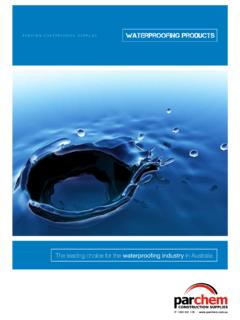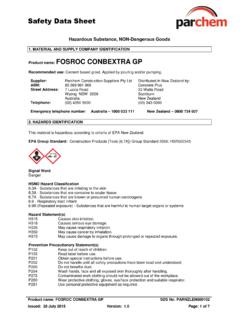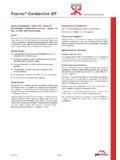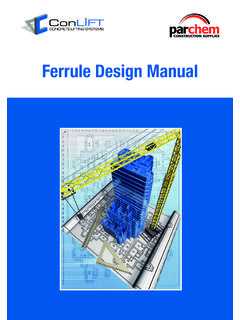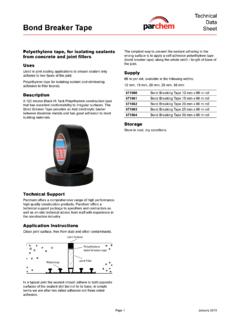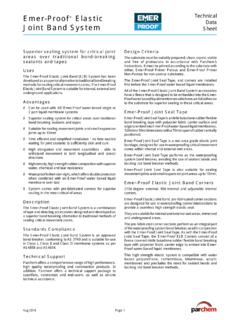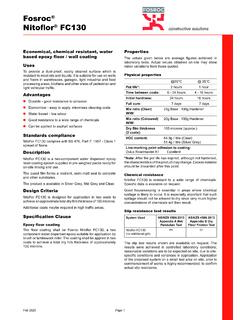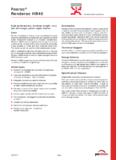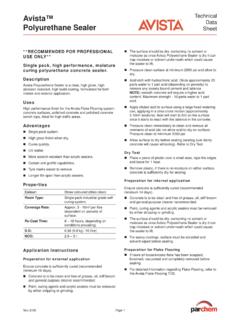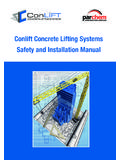Transcription of Fosroc Paveroc constructive solutions - Parchem
1 Page 1 Oct 2017constructive solutionsFosroc PaverocFloor / pavement large area, repair mortar (15-50 mm depth)UsesFor the reinstatement of large areas of concrete pavements and floors to avoid the total replacement of bays. The rapid strength gain of Paveroc will ensure that down-time is significantly reduced. The product is alkaline in nature and will protect embedded steel reinforcement. It may be used internally and emergency patching of small areas of concrete pavements and floors, the use of Patchroc GP is Rapid strength gain - will generally accept pedestrian traffic at 16 hours High strength.
2 Abrasion and weather resistance Single component product eliminates site batching and requires only the site addition of clean water Excellent bond to the concrete substrate Shrinkage compensated Contains no chloride admixturesDescriptionPaveroc is supplied as a ready to use blend of dry powders which requires only the site addition of clean water to produce a highly consistent, high strength repair mortar for large areas of concrete pavements and floors. The material is based on a blend of cements, graded aggregates, special fillers and chemical additives to provide a mortar with good handling characteristics, while minimising water demand.
3 Paveroc exhibits excellent thermal compatibility with concrete and good water repellent properties. The low water requirement ensures fast strength gain and long- term SupportParchem offers a technical support service to specifiers, end-users and contractors, as well as on-site technical CriteriaPaveroc is designed for horizontal use. It may be applied up to a maximum thickness of 50 mm. Thicker sections can be built up in layers. The material should not be applied at less than 15 mm thickness. Individual bay sizes should not exceed 18 m2 @ 50 mm thickness and 5 m2 @ 15 mm thickness.
4 Consult your local Parchem sales office for further following results were obtained using litres of water per 20 kg bag of resultCompressive strength at 23 C20 MPa @ 1 day40 MPa @ 7 days55 MPa @ 28 daysWorking life:2 hours @ 23 CSetting time at 23 C:Initial set - 5 hours Final set - 7 hoursTraffic time:PedestrianVehicular30 hours @ 15 C16 hours @ 23 C 12 hours @ 30 C54 hours @ 15 C 24 hours @ 23 C 20 hours @ 30 CFresh wet density:Approximately 2300 kg / m3 dependent on consistency Application InstructionsNotesTo avoid possible reflective cracking in the Paveroc repair, it is essential that live cracks and joints in the substrate be given proper attention.
5 Due consideration must always be given to existing joint details and these must be followed through the Paveroc repair; live cracks should be treated by an approved method. For further information, contact your local Parchem sales cut or cut back the extremities of the repair locations to a depth of at least 10 mm to avoid feather-edging and to provide a square edge. Break out the complete repair area to a minimum depth of 15 mm up to the sawn the surface and remove any dust, unsound or contaminated material, plaster, oil, paint, grease, corrosion deposits or algae.
6 Where breaking out is not required, roughen the surface and remove any laitance by light scabbling, grit-blasting, scabbling or by needle-gun to form a good key. Oil and grease deposits should be removed by steam cleaning, detergent scrubbing or the use of a proprietary degreaser. The effectiveness of decontamination should then be assessed by a pull-off fully any corroded steel in the repair area and remove all loose scale and corrosion deposits. Steel should be cleaned to a bright condition paying particular attention to the back of exposed steel bars. Grit-blasting is recommended for this 2constructive solutionsFosroc PaverocWhere corrosion has occurred due to the presence of chlorides, the steel should be high pressure washed with clean water immediately after grit-blasting to remove corrosion products from pits and imperfections within its prepared area should be blown clean with oil-free compressed steel primingApply one full coat of Nitoprime Zincrich to all exposed reinforcing steel and allow to dry before continuing.
7 If any doubt exists about having achieved an unbroken coating, a second application should be made and, again, allowed to dry before primingThe substrate should be thoroughly soaked with clean water and any excess removed immediately prior to priming. Any areas of the substrate which dry out before application of the primer must be redampened before continuing. Thoroughly scrub Nitobond AR or diluted Nitoprime 330 (4:1 with water) into the dampened surface taking care to ensure complete coverage particularly around the the topping whilst the Nitobond AR or Nitoprime 330 is still tacky.
8 The priming operation must be repeated if the initial coat has dried exceptional circumstances, eg; where a substrate/repair barrier is required or where the substrate is wet or likely to remain permanently damp, Nitobond EP bonding aid should be used. Contact your local Parchem sales office for further should be taken to ensure that Paveroc is thoroughly mixed. A forced-action mixer is essential. Mixing at a slow speed (400/500 rpm) in a suitably sized drum using appropriate equipment such the Ransom 140 x 600 M14 Helical mixing paddle (product code: N4020892-UNIT) fitted to a heavy-duty 1600W mixer, such as Ransom 1602 E (product code: NP7EV160-UNIT) or equivalent is acceptable for one-bag mixes.
9 Free-fall mixers must not be used. Place drinking quality water into the mixer and, with the machine in operation, add one full 20 kg bag of Paveroc and mix for 3 minutes until fully homogeneous. Note that powder must always be added to :Water Addition (Litres)Yield(Litres)Stiff - - part bagsIt is recommended that full bags be mixed, however for applications where smaller quantities of product are required, experienced applicators may elect to mix half bags by weighing out (the correct quantity of product) and mixing with half the recommended quantity of water.
10 In doing so the contractor accepts the risk of any off-ratio mixing. Agitate the dry product before weighing out to minimise any segregation. Reliable scales should be used to weigh out individual mixed Paveroc must be applied on to the primed surface before it dries. Areas which dry too soon must be scrubbed clean and reprimed exactly as described above before continuing. Apply the mixed Paveroc on to the primed substrate as soon as possible after mixing. The mortar should be applied evenly by trowel and tamped in place with a wood float to ensure full compaction.
